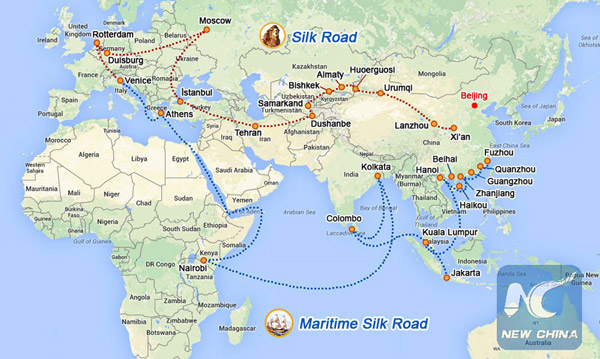
Picture shows the Silk Road Economic Belt and the 21st Century Maritime Silk Road, collectively known as the Belt and Road initiative. (Xinhua)
XI'AN, May 15 -- While China's western provinces mainly depend on their affluent eastern peers for investment, a national strategy to revive the centuries-old trading routes connecting Asia, Europe and Africa gives them the unique advantage of "looking west" for development opportunities.
Over the weekend, more than 12,000 officials and businessmen from 37 countries and regions, and delegations from 27 Chinese provinces convened in Xi'an, the capital of Shaanxi Province, for the Silk Road International Exposition, or the 20th Investment and Trade Forum for Cooperation between East and West China (ITFCEW).
More than 20 topics including streamlining customs declarations, tourism and business cooperation will be discussed.
FROM HINTERLAND TO HEARTLAND
Three decades of reform and opening up have given China prosperity, but unbalanced development between the east and the west is an outstanding problem.
Landlocked western provinces used to rely on mechanisms like ITFCEW for business opportunities. Inter-provincial investment deals reached during such a forum have grown from 29 billion yuan (4.5 billion U.S. dollars) in 1997 when it was launched to 790 billion yuan in 2013.
As the Chinese economy moderates in its transition and eastern provinces strive for new ways forward, west China is in an urgent need of new platforms to keep its economy rolling.
Proposed in 2013, the Belt and Road Initiative -- the Silk Road Economic Belt and the 21st-Century Maritime Silk Road -- works for improved cooperation between China and countries in a vast part of Asia, Europe and Africa.
The Chinese government published an action plan specifying the principles, framework, priorities and mechanisms for the initiative in March last year. A 40-billion-dollar Silk Road Fund, designed to finance the Belt and Road, was launched last year.
The initiative soon gained traction. Direct investment in 49 countries along the Belt and Road route rose 18.2 percent to 14.8 billion dollars in 2015, accounting for 12.6 percent of China's total outbound investment. Bilateral trade volume between China and these countries reached 995.5 billion dollars, or a quarter of China's total trade volume.
To reflect this latest development, the ITFCEW forum has been officially given the prefix the Silk Road International Exposition since this year.
As the eastern end of the ancient Silk Road, Shaanxi has achieved renewed prominence, serving as a bridgehead connecting China with Belt and Road countries. An International freight train launched in 2013 starts from Xi'an and reaches central Asian countries including Kazakhstan, Uzbekistan and Kyrgyzstan. Freight time between Xi'an and Almaty in Kazakhstan has been cut to six days, 20 days fewer than by road.
Shaanxi planned to invest 236 million dollars in central Asia last year, a notable rise in value and cooperation ranging from petrochemical engineering and agriculture to textile and construction materials, according to Yao Chaoying, head of the Shaanxi commerce department.
"We see vast opportunities in Belt and Road countries, especially in construction, given their vast territories, huge population and fast development," said Liu Yaohua, chair of the Shaanxi Construction Engineering Group Corp., during the forum.
The company reached an agreement with Kyrgyzstan in May last year to build an industrial park and 10,000 affordable houses.
MUTUAL BENEFIT, LONG-TERM POTENTIAL
The Belt and Road Initiative and the reinvigoration of Silk Road are not only welcome news for China, they hold enormous promise for countries along the route.
Temir Assanov, a managing director at Kazakhstan's JSC Astana Innovations, a state-owned company that coordinates innovation in Astana, told Xinhua that he came to Xi'an with over 60 projects seeking cooperation.
These projects include schools, hospitals and ski resorts, he said.
"Thanks to Kazakhstan's zero-tax policy for these projects and other conveniences like visas, my proposals have been well received. Several companies have expressed interest," he said. A former student of Peking University, Assanov speaks fluent Chinese.
Marat Sharshekeev, president of Chamber of Commerce and Industry of Kyrgyzstan, said he was impressed by the opportunities in Xi'an and would "encourage Kyrgyzstan companies to participate in the Silk Road Expo regularly."
More and more young people of Belt and Road countries are studying in China. In 2014, students from Kazakhstan in China reached around 12,000.
"These students can be cultural envoys and will bring our countries closer," Assanov said.